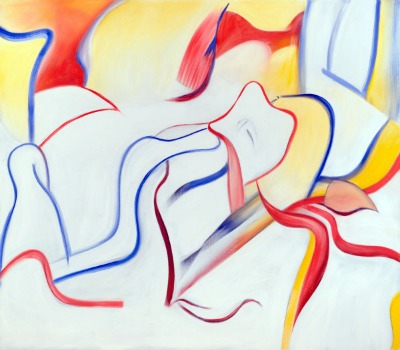Willem de Kooning, a 20th century artist, was recently the focus of my Sunday afternoon, and all in good reason. He was a very notable artist due to the changes and contributions he made in abstract art, but also because he challenged himself in his art work and as a result grew as an artist. One can see these changes and personal experiments by examining his early works, his later works, and most importantly, the works that allowed him to progress from beginning to end.
De Kooning began his artistic career with commercial art and early abstract art. An example of his early works is his painting Father, Mother, Sister, Brother (1937). In this painting, he uses the three primary colors; red, blue, and yellow on a white canvas. It appears as though the blue figures are the father and brother while the red figures are the mother and sister. It is considered abstract but it is so simple that inferring which figures represent what roles is not too challenging. Although his early works were very simple, his future art works became more complex and detailed. From commercial art and simple abstractions he was led into modernized figurative drawings such as his Portrait of Elaine (1940-41) and from there he started his famous Woman paintings series. We can see the use of his geometric shapes and abstractions in his painting Pink Lady (1944), which depicts a seated woman with her head, tilted back in one direction and her body erect in another. The positioning of the woman in the painting is humanly impossible and a little frightening to be honest. It also seems as though there are two faces joined together in this painting. De Kooning focused much of his career on Woman paintings however he also did black and white paintings such as Painting (1948), abstract landscaping done with large-scale brush strokes – Suburb in Havana (1958), sculpture and printmaking – Seated Woman on a bench (1972), and finally ended his career with reductive abstractions such as Untitled XIX (1983).
Looking at the span of his artistic career, we can notice times of very simple abstractions and times of very “busy” and intricate abstractions as well as his favorite media (oil paints and charcoal). De Kooning can be said to have experimented with the extremes. He did art works in which human figures were very realistic and works in which they were very abstract. He also did large-scale projects and miniature projects. By working with such opposites, he made a large impact on art history and push the limits of what can be created with a little imagination. De Kooning was a truly talented artist and this MOMA exhibit did a wonderful job portraying him as one. Bravo MOMA!

Early work of De Kooning

Late work of De Kooning

